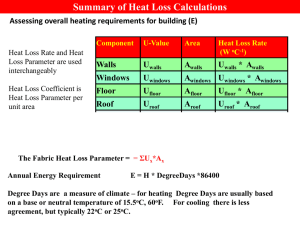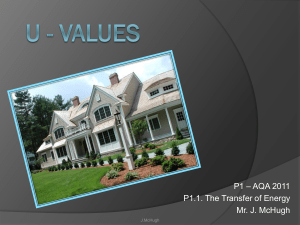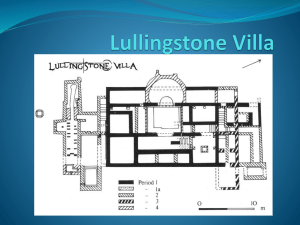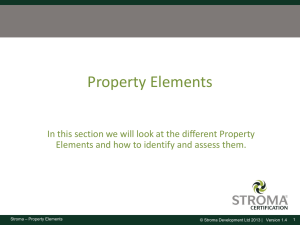Portfolio Info - The Energy Link
advertisement
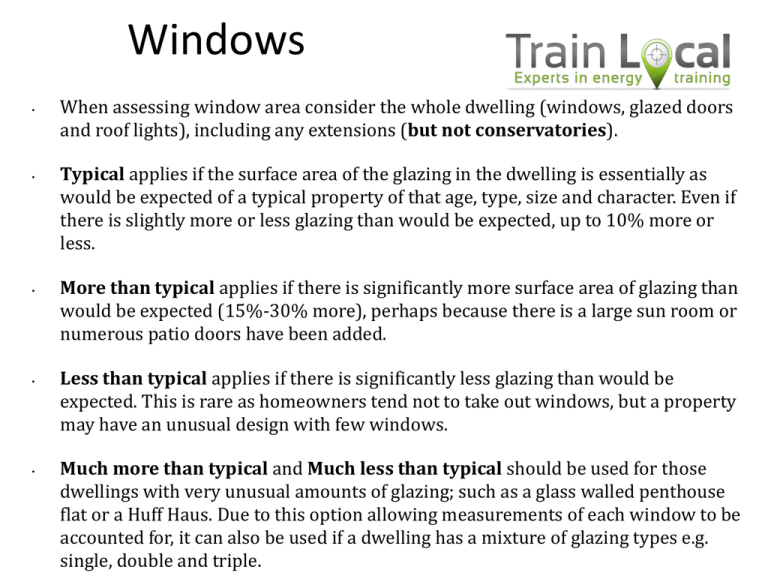
Windows • • • • • When assessing window area consider the whole dwelling (windows, glazed doors and roof lights), including any extensions (but not conservatories). Typical applies if the surface area of the glazing in the dwelling is essentially as would be expected of a typical property of that age, type, size and character. Even if there is slightly more or less glazing than would be expected, up to 10% more or less. More than typical applies if there is significantly more surface area of glazing than would be expected (15%-30% more), perhaps because there is a large sun room or numerous patio doors have been added. Less than typical applies if there is significantly less glazing than would be expected. This is rare as homeowners tend not to take out windows, but a property may have an unusual design with few windows. Much more than typical and Much less than typical should be used for those dwellings with very unusual amounts of glazing; such as a glass walled penthouse flat or a Huff Haus. Due to this option allowing measurements of each window to be accounted for, it can also be used if a dwelling has a mixture of glazing types e.g. single, double and triple. Window U-values and g-values • • U-values and g-values for windows can be overwritten only if documentary evidence is provided, which can be either a Window Energy Rating certificate (as defined by BFRC) or manufacturer’s data. The U-value is for whole window, not centre pane. Use Table S14 Appendix S - Doors • • In RdSAP the definition of what is a window and what is a door is defined by the area of glazing in relation to the area of the whole opening, i.e. door and frame. To be classed as a window a glazed door and frame must contain glazing amounting to 60% or more or its surface area. An external door is a door that forms part of the heat loss perimeter of the dwelling. A door to a heated access corridor is not included in the door count. External Doors • • • A door is counted as insulated only if documentary evidence is provided, which must include U-value or manufacturer reference enabling the assessor to ascertain the U-value from the manufacturer. If there is more than one insulated door and they have different U-values, enter the average U-value. Draft proofing • • RDSAP 9.91 requires the DEA to assess and collect the number of windows and doors that are draught proofed to allow a more accurate recommendation for draught proofing. Look for draught strip around doors and windows. With multiple glazed windows open the windows and check the seals. Draught proofing • • • • • All external doors and at least 2 windows per building part should be examined. If a window is locked or inaccessible then endeavour to check another one. If the state of the draught proofing cannot be determined then take triple, double or secondary glazed as being draught proofed, and single glazed windows and doors as not draught stripped. Include glazing in a non-separated conservatory. The percentage draught proofed is [(number of draught proofed windows & doors) divided by (total number of windows & doors)] x 100 External Doors • • • A door is counted as insulated only if documentary evidence is provided, which must include U-value or manufacturer reference enabling the assessor to ascertain the U-value from the manufacturer. If there is more than one insulated door and they have different U-values, enter the average U-value. Standard Assessment Procedure • Full SAP is used in Building Regulations, and has to be calculated for every new home built, for new extensions and conversions Introduction of RDSAP • The RDSAP (Reduced Data SAP Rating) has been developed to provide a consistent method for existing houses Reduced Data set than Full SAP standardised methodology for energy rating existing properties Assumptions • Assumes – standard occupancy – standard heating pattern – lighting – Locality Running costs calculated using a standard (average) heating pattern of 9hours heating a day during the week and 16 hours a day at the weekend • Living area heated to 21°C and the rest of the house to 18°C • Excludes (factors that do not affect RdSAP conventions) – cost of cooking – running other appliances – Rating is not affected by living habits of the occupying households RdSAP changes • • • • Appendix S – Main guidance of criteria for survey techniques Appendix T – Improvement Measures guidance Conventions – this is to standardise, provide consistency and ensure DEAs are compliant. They are developed by the stakeholder group and formally released by CLG (formerly DCLG) New changes highlighted in blue for 2012 Draught proofing is a cheap and efficient method of saving both energy and money • • Draughts are similar to ventilation in that they supply the home with fresh air. However, draughts are uncontrolled and can let in too much cold air as well as allowing heat to escape. Draught proofing blocks up any unwanted gaps that let cold air in • Types of draught proofing can include: • – Self adhesive sealant strips • – Brushes • – Spray foams (sprayed into gaps around windows) Habitable rooms This is a simple count of the number of habitable rooms in the dwelling Habitable rooms include living room, sitting room, dining room, bedroom, study and similar; The count of habitable rooms excludes hall, stairs and landing, kitchen, utility room, bathroom, cloakroom, en-suite and similar Where there are ‘open plan’ rooms, count as 1 room. A lounge/dining room with the door permanently removed (hinge holes filled etc) is one habitable room In addition to the above, if half or more of the habitable rooms are not heated these rooms should be recorded on the survey form (for inadequate heating purposes). For a kitchen to be a kitchen/diner it must have space for a table and 4 chairs A lounge/dining room where the door was temporarily removed (ie architrave and hinges still there) is two habitable rooms An non-separated conservatory adds to the habitable room count if it has an internal quality door between it and the dwelling. Some important definitions • • • Heat Loss Wall – is one which separates the heated part of the dwelling from the unheated external environment or a part of the dwelling which is unheated i.e. a wall through which heat will be lost Party Wall – is a shared wall between two properties which may be semi-detached, terraced or flats Party walls are not considered heat loss walls as losses or gains through party walls to other dwellings (or premises that are normally expected to be heated) are assumed to be zero. Measuring buildings • A lot of the data required from inspection relates to measurement of floor areas. • RICS Code of Measuring Practice • Gross Internal Area (GIA) • • • “Gross Internal Area is the area of a building measured to the internal face of the perimeter walls at each floor level.” Party walls in shared ownership are to be measured to their centre line Excludes perimeter wall thickness and external projections So what do we actually have to measure? Floor Dimensions – • • • • • Measure between the inner surfaces of the external or party walls, disregarding the presence of any internal walls Alternatively, the external walls of the building can be measured and used instead; the software then converts these figures, making an allowance for the thickness of the walls When entering measurement data, you are required to indicate which measurements are being used – internal or external. Stairs - the floor area should be measured as if there were no stairs but a floor in their place at each level. Built-in Cupboards should be included in the calculation of the floor area where these are directly accessible from the occupied area of the dwelling. A SET OF 6 FLATS SEPARATED BY A ‘HEATED’ ACCESS CORRIDOR. • Flat A is an Enclosed End-Terrace flat that has two heat loss walls, 5+4 = 9m. The access corridor is heated and the wall between the flat and corridor is deemed to be a party wall and as such no heat loss is calculated through it. A SET OF 6 FLATS SEPARATED BY A ‘HEATED’ ACCESS CORRIDOR. • Flat B is an Enclosed Mid-Terrace flat, and has just one heat loss wall measuring 4m. Example 5 This set of 6 flats is separated by an ‘unheated’ access corridor. Flat A is an Enclosed End-Terrace flat that has three heat loss walls, 4+5+4 = 13m. Flat B is an Enclosed Mid-Terrace flat, and has two heat loss walls, 4+4 = 8m. Floor type considerations Suspended Timber and suspended Concrete – look for air bricks at the lower levels of the property Solid – there is no air brick and the floor has not steps towards the entrance of the property You must also indicate what is on the other side of the floor such as Ground floor, Above heated space, same dwelling below etc Flats and position • When we deal with a flat, we have to consider the position it occupies in the block of flats. We do this by starting from the ground floor, mid-floor and top floor Bay windows calculations How to measure wall thickness 1. Take a measurement at door or window reveals • • • • A difference in wall thickness is not in itself a reason to include an alternative wall, unless it is a stone wall and the dif-ference in thickness is greater than 100 mm. Disregard when less than 10% of total exposed wall area of the building part (including windows and doors) unless documentary or visual evidence exists of different retrofitted insulation either of the alternative wall or of the remaining wall in the building part. When entering alternative wall area into the software exclude the area of any windows and doors contained in the alternative wall. Consolidate walls of same type. Walls: Dry-lining • • Dry-lining is the addition of plaster board to an existing wall, either with dabs of plaster, on battens, or lath and plaster. Drylining is any wall lining with no insulation which creates an air space behind it. Although dry lining alone is not insulation, it can reduce the U-value significantly. It may be applied to ‘straighten’ an old uneven wall. The presence of dry-lining should only be assessed when insulation is as-built or unknown and for the following wall constructions: • Granite or Whinstone • Sandstone • Solid brick • • • • YOU CAN ASSESS DRYLINING BY TAPPING THE WALL: Dabs of plaster adhesive will make a different sound to the rest of the plaster board Battens will sound solid, the air gaps in between will sound hollow Lath and plaster will normally be visible in cupboards and should produce a hollow sound when tapped If you are in doubt, do not select dry-lined. Internal Wall Lining • • • This is a new convention for the new RDSAP 9.91 data collection ‘dry-lining’ or ‘internal wall lining (creating an air space behind)’. This includes any type of internal lining that creates an airspace behind it, e.g. plasterboard on dabs, lath and plaster. Use tap test for plaster board on dabs or on battens. If tap test is inconclusive regard as not drylined. Note: This applies only to stone or solid brick walls. Heat loss floor area for houses and bungalows • • The area of the lowest occupied floor of the main dwelling is a ground floor. If the lowest occupied floor of any extension is not a ground floor increase the level of each storey in that building part by 1 for the purposes of the SAP calculation. For each building part examine the floor areas on each storey. If the area of any upper floor is greater than that of the floor below, the difference in these areas is an exposed or semiexposed floor. This can occur particularly when there is an integral garage. When external dimensions are being used, however, the method of dimensional conversion can result in a small, but spurious, exposed floor area. To avoid that situation., the area of exposed floor on any level cannot be greater than the difference between the area of the current floor and the floor below measured using external dimensions. U-value and insulation are mutually exclusive. If U-value is known, the U-value should be entered and ‘Insulation thickness’ is not relevant Stores & utility rooms • • should be included if they are directly accessible from the occupied area of the dwelling, whether heated or not should not be included if they are unheated and accessible only via a separate external door. Basements should be included only if consisting of heated and habitable rooms. Include when accessed via a permanent fixed staircase such that one is able to walk downwards facing forwards and either:basement is heated via fixed heat emitters, or basement is open to the rest of the dwelling. Does not necessarily contain habitable rooms. Garages should be included if heating is provided within the garage from the main central heating system should not be included where the garage is thermally separated from the dwelling and is not heated by the central heating system. Attics should be included if they are habitable rooms, accessed by a fixed staircase and have natural light Roof spaces should not be included unless they are habitable rooms accessed by a fixed staircase and access to natural light DETAILED MEASUREMENTS OF ROOF ROOMS • • • • Detailed measurements of roof rooms are required only if evidence exists that the slope, stud wall (or common wall) or gable wall (see Figure S3) have differing levels of insulation and each of their U values is known. See Figure S3. If all elements of the roof room (slope/stud/gable) have the same insulation and the U-value is available, the U-value can be overwritten whilst leaving the RdSAP assumed areas as is. Where detailed measurements are made and the floor area of the parts of the dormer windows protruding beyond the roof line is less than 20% of the floor area of the roof room, measure the elements of the roof room as if the dormers were not there. Otherwise total the vertical elements of all dormers in that building part and enter as stud wall and the flat ceiling elements as flat ceiling. A roof room is indicated as ‘connected’ if it is adjacent to (i.e. at the same level as) another building part of the same dwelling (which can be either a roof room or a normal storey). For detailed measurements of roof rooms there can be up to two of each of: - flat ceiling - sloping ceiling - stud wall (or common wall) - gable wall A U-value must be provided for each non-zero area. Figure S3 : Different parts of roof rooms Partially insulated roof rooms When roof room details are collected, the following data can be entered: – Actual area – Actual U-value Position of Flats in Block • • • • When assessing a flat an assessor is now required to record 2 elements for flats; 1. Which floor, 0,1,2,3, etc.? Where the ground/basement level is recorded as 0, 2. What floor type is the flats lowest occupied floor in the block, as one of the following options; – Basement – Ground-floor – Mid-floor – Top-floor This data is not used in the actual calculation, but it enables the assessor to control what is written for dwelling type on the EPC. Heating systems • What provides space heating? • Primary heating system • Heats the largest proportion of a dwelling • Not normally based on individual room heaters ( for example gas fires in most rooms) although it can be • Often provides hot water • Includes: – Central heating systems with radiators or underfloor heating – Community heating – Electric storage systems – Electric underfloor heating – Warm air systems – Room heaters • Secondary heating system • Based on a room heater • • Secondary heating system is to be specified if the main heating system is not sufficient to heat the dwelling to levels that SAP is based on These levels are 21°C in living areas and 18°C elsewhere Gas Mains gas LPG Bottled Electricity Tariffs 7-hour off-peak (Economy 7) – typically Dual electric meters 10-hour off-peak = time for space & water heating 24-hour = On-peak – typically for single electric meters and key meters Definitions • • Boiler – Gas or liquid fuelled appliance designed to provide hot water for space heating – May or may not provide domestic hot water as well Condensing boiler – Designed to make use of the latent heat released by the condensation of water vapour; boiler allows condensate to leave heat exchanger in form of condensate Solar Water Heating



